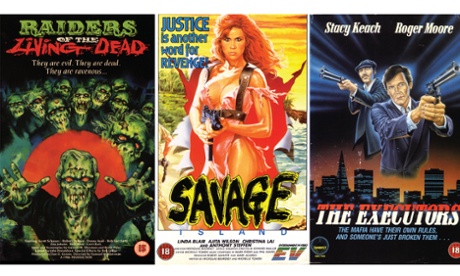
Any child of the 1980s or 90s could tell you the pivotal role the video shop played in their lives. Once a fixture of Britain’s high streets, they’ve since gone the way of Woolworths, Our Price and Wimpy, becoming virtually extinct with the advent of Netflix, Amazon and iTunes.
But the new book VHS Video Cover Art, compiled by British poster artist and graphic designer Tom Hodge (who works under the name the Dude Designs), has recreated the experience of browsing dusty shelves filled with more Steven Seagal action movies and Porky’s knock-offs than anyone could possibly want. More to the point, the book makes a compelling case for re-evaluating the packaging of those films, known in the trade as “key art”.
Hodge – who made his name designing a poster for the cult Rutger Hauer movie Hobo With a Shotgun, a throwback to lurid and violent 80s exploitation films – says his early exposure to video-box art “shaped my visual aesthetic”. The first video he ever saw “was a fourth or fifth generation pirate of Rambo II”. Hodge, who progressed to taping films off the television and making his own sleeves in the style of those he saw on the shelves, is still in thrall to “that buzz of going to the video shop and seeing all these rows and rows of videos on the plastic shelves … and just staring for hours at the different covers, trying to decide on one”. The videos, he says, “were in such close proximity, [the covers] had to be louder and brasher than the next one”.
If Hodge’s book is anything to go by, 80s video sleeves often featured vivid illustrations of ripped, mean-looking men brandishing heavy weaponry; scantily clad busty dames doing much the same; demons, psychopaths and explosions galore, all rendered in electric blues, blood reds and shocking pinks. But the covers in the book are more than simply a collection of kitschy trash culture. They’re continuing a tradition dating back to the art that graced pulp magazines of the 20s and 30s, through to men’s magazines and pulp paperbacks of the 50s and 60s.
Among the undisputed masters were three Italians: Enzo Sciotti, who drew posters for Dario Argento movies such as Phenomena; Renato Casaro, best known for his poster of the Arnold Schwarzenegger film Conan the Barbarian; and his son Claudio. Sciotti, says Hodge, “was quite a refined artist”, as adept at producing oil landscapes as monsters and mercenaries. The Casaros, while revered as poster artists, doubled as fine artists. Also represented is England’s premier video-cover artist, Graham Humphreys, known for his classic key art for Sam Raimi’s Evil Dead.
Most of the covers in Hodge’s book were sourced from two collectors, Dale Lloyd and Phil Baker, who respectively blog their collections at Viva VHS and Video Collector; they have more than 9,000 tapes between them. Hodge picked out the sleeves that caught his eye, then whittled them down according to “artistic merit”. The book contains 240 sleeves, back and front, arranged alphabetically and by genre – action, comedy, horror, kids, sci-fi and thriller – complete with scuffs and tears. “I wanted them to be these objets d’art,” says Hodge, “frayed and with stickers, because that’s how I remember them.”
The book doubles as a survey of long-forgotten, straight-to-video films their stars might have hoped would stay that way: Roger Moore (The Executors), Kevin Bacon (The Demon Murder Case), Max von Sydow (Lunatic) and one-time Bond George Lazenby (Death Dimension).
This kind of cover art was the result of two things: the video boom of the 80s and 90s that pushed the concept of “home entertainment” (the UK apparently boasted the world’s highest number of video-cassette recorders per capita) but also the mid-80s moral panic over “video nasties”, when the Thatcher government clamped down on the then-entirely unregulated VHS market by broadening the powers of the British Board of Film Classification. In an act of self-regulation, the British Video Association set up the rathe rominous-sounding Video Packaging Review Committee, whose logo was stamped on approved sleeves as a kitemark, and certification was withheld from films until their sleeves were approved by the committee, ensuring that, according to writer Jason Arnopp, “lurid box art went the same way as TV cigarette ads”.
Early video nasties tried to get the most gruesome images on the front cover. Abel Ferrara’s notorious The Driller Killer featured a still from the film that left nothing to the imagination and a tagline that only made it worse: “The blood runs in rivers … and the drill keeps tearing through flesh and bone.” VHS cover art became more prevalent, Hodge believes, because illustrations were not deemed as offensive as a photograph.
Commissions for artists such as Sciotti and the Casaros dried up with the advent of DVDs and the corporatisation of video companies, who homogenised cover art through focus-grouped designs that could be produced cheaply with Photoshop. In recent years, however, there has been a move back to the aesthetic of VHS – not just the packaging but also the experience of watching movies on grainy video tape. “It’s not something in this digital age that you can recreate,” says Hodge. “It’s almost like film, but it’s not. And it almost feels like film in your hand. And the box has got substance to it.” This new fetishisation of videotape, which has flourished online, extends to the Timeless VHS Instagram account, which reimagines contemporary films and TV shows such as Wolf of Wall Street and Game of Thrones as VHS box art.
Ultimately, Hodge’s book gives weight to the idea that the more compelling the cover art, the more execrable the movie it’s trying to sell. “But,” he says, “that was always the way.”
• VHS Video Cover Art is published by Schiffer.

